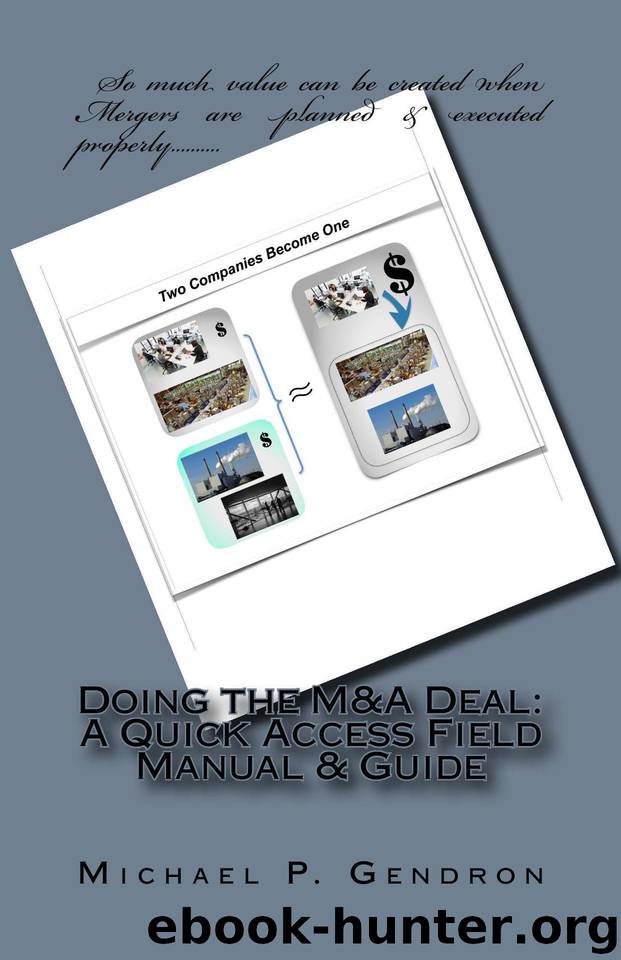Doing the M&A Deal: A Quick Access Field Manual & Guide by Gendron Michael

Author:Gendron, Michael
Language: eng
Format: epub
Publisher: Unknown
Published: 2016-03-11T16:00:00+00:00
See examples of standard review templates for the presentation in Exhibit 19. Assign each executive’s review time based on importance to achieving the acquisition goal. For example, accounting may have a minor impact on the success of the transaction, while the sales force will be essential. The Integration executive may allocate the sales function two hours for review, while the finance function will receive 30 minutes since there may be less business risk in the finance function. The individual executive review will ensure organizational alignment. If executives disagree about the goals and structure, differences will be resolved at this time.
This segment of the workshop will be similar to the high-level summary, and will include information from each executive such as:
o Confirmed valuation assumptions
o High-level business model (see Exhibit 13)
o Process review and changes required
o Organization structure and key constituents
o Keys to valuation as applicable to the functions
o Gap analysis
o Financial summaries
2.4.4.1 Entire value chain by function
Functional executives will review their portion of the critical value chain elements to ensure agreement among the workshop executives. During the workshop, executives will review up to 10 summaries. They will review one summary for each element of the value chain depicted in Exhibit 4.
2.4.4.1.1 Confirm valuation assumptions
Each executive will review the critical valuation assumptions as they relate to their function to ensure that all executives have a thorough and common understanding of the deal. For example, if a key to valuation is increasing manufacturing throughput by 25 % without any increase in manufacturing overhead, the responsible executive should state that the saving is achievable. Functions that are not essential elements of the valuation will work to achieve the overall acquisition goal.
2.4.4.1.2 “To Be” state
Prepare a summary of the “To Be” state of the combined operations at specific and significant time intervals. Important time intervals may be at 100 days, six months, and one year. These intervals will vary with each transaction. Identify factors that are measurable and consistent with the overall acquisition strategy. For example, if a key to valuation is increasing manufacturing throughput by 25 % within 12 months, without any increase in manufacturing overhead, the responsible executive should state that the savings are achievable.
2.4.4.1.3 High Level Business Model
While considering confidential matters, each executive will review the personnel/organization, and constituency. Factors such as critical personnel, or other constituents, organization size and structure, changes in compensation, benefits, and expanded and reduced staff levels should be discussed, if critical. Each executive will summarize the “As Is”, and the “To Be” organization, and review transition plans to reach the goal. During this process, executives will identify and discuss organizational or constituency gaps and plans to resolve the gap through hiring, improving processes, or investing in plant/assets to eliminate the gap. For example, if the manufacturing organization in the acquired company does not use Computer Assisted Design/Manufacturing (CAD/CAM) equipment, add CAD/CAM trained engineers to the organization to raise the performance standards at the target company.
Download
This site does not store any files on its server. We only index and link to content provided by other sites. Please contact the content providers to delete copyright contents if any and email us, we'll remove relevant links or contents immediately.
Hit Refresh by Satya Nadella(9011)
The Compound Effect by Darren Hardy(8771)
Change Your Questions, Change Your Life by Marilee Adams(7599)
Nudge - Improving Decisions about Health, Wealth, and Happiness by Thaler Sunstein(7521)
The Black Swan by Nassim Nicholas Taleb(6979)
Deep Work by Cal Newport(6844)
Daring Greatly by Brene Brown(6409)
Rich Dad Poor Dad by Robert T. Kiyosaki(6349)
Principles: Life and Work by Ray Dalio(6164)
Man-made Catastrophes and Risk Information Concealment by Dmitry Chernov & Didier Sornette(5895)
Playing to Win_ How Strategy Really Works by A.G. Lafley & Roger L. Martin(5837)
Digital Minimalism by Cal Newport;(5621)
Big Magic: Creative Living Beyond Fear by Elizabeth Gilbert(5574)
The Myth of the Strong Leader by Archie Brown(5395)
The Slight Edge by Jeff Olson(5331)
Discipline Equals Freedom by Jocko Willink(5252)
The Motivation Myth by Jeff Haden(5138)
Stone's Rules by Roger Stone(5005)
The Laws of Human Nature by Robert Greene(4960)
